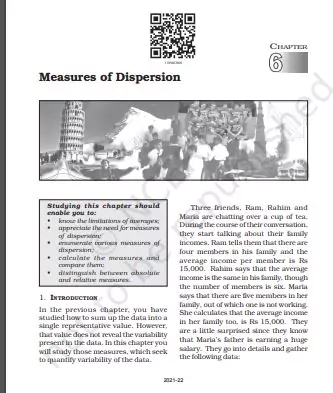‘NCERT Solutions for Class 11 Statistics Chapter 6 Organisation of Data‘ PDF Quick download link is given at the bottom of this article. You can see the PDF demo, size of the PDF, page numbers, and direct download Free PDF of ‘Ncert Class 11 Statistics Chapter 6 Exercise Solution’ using the download button.
Measures of Dispersion Book PDF Free Download

Chapter 6: Measures of Dispersion
In the previous chapter, you have studied how to sum up the data into a single representative value. However, that value does not reveal the variability present in the data. In this chapter you will study those measures, which seek to quantify variability of the data. Three friends, Ram, Rahim and Maria are chatting over a cup of tea. During the course of their conversation, they start talking about their family incomes. Ram tells them that there are four members in his family and the average income per member is Rs 15,000. Rahim says that the average income is the same in his family, though the number of members is six.
Maria says that there are five members in her family, out of which one is not working. She calculates that the average income in her family too, is Rs 15,000. They are a little surprised since they know that Maria’s father is earning a huge salary. They go into details and gather the following data: Do you notice that although the average is the same, there are considerable differences in individual incomes? It is quite obvious that averages try to tell only one aspect of a distribution i.e. a representative size of the values. To understand it better, you need to know the spread of values also.
You can see that in Ram’s family, differences in incomes are comparatively lower. In Rahim’s family, differences are higher and in Maria’s family, the differences are the highest. Knowledge of only average is insufficient. If you have another value which reflects the quantum of variation in values, your understanding of a distribution improves considerably. For example, per capita income gives only the average income.
A measure of dispersion can tell you about income inequalities, thereby improving the understanding of the relative standards of living enjoyed by different strata of society. Dispersion is the extent to which values in a distribution differ from the average of the distribution. To quantify the extent of the variation, there are certain measures namely: (i) Range (ii) Quartile Deviation (iii) Mean Deviation (iv) Standard Deviation Apart from these measures which give a numerical value, there is a graphic method for estimating dispersion.
Range and quartile deviation measure the dispersion by calculating the spread within which the values lie. Mean deviation and standard deviation calculate the extent to which the values differ from the average.
MEASURES BASED UPON SPREAD OF VALUES
Range Range (R) is the difference between the largest (L) and the smallest value (S) in a distribution. Thus, R = L – S Higher value of range implies higher dispersion and vice-versa. Notwithstanding some limitations, range is understood and used frequently because of its simplicity. For example, we see the maximum and minimum temperatures of different cities almost daily on our TV screens and form judgments about the temperature variations in them. Quartile Deviation The presence of even one extremely high or low value in a distribution can reduce the utility of range as a measure of dispersion.
Thus, you may need a measure which is not unduly affected by the outliers. In such a situation, if the entire data is divided into four equal parts, each containing 25% of the values, we get the values of quartiles and median. (You have already read about these in Chapter 5).
The upper and lower quartiles (Q3 and Q1 , respectively) are used to calculate inter-quartile range which is Q3 – Q1 . Interquartile range is based upon middle 50% of the values in a distribution and is, therefore, not affected by extreme values. Half of the inter-quartile range is called quartile deviation (Q.D.).
| Author | NCERT |
| Language | English |
| No. of Pages | 17 |
| PDF Size | 1.6 MB |
| Category | Statistics |
| Source/Credits | ncert.nic.in |
NCERT Solutions Class 11 Statistics Chapter 6 Measures of Dispersion
Question 1.
A measure of dispersion is a good supplement to the central value in understanding a frequency distribution. Comment.
Answer:
Dispersion is the extent to which values in a distribution differ from the avarage of the distribution. Knowledge of only average is insufficient as it does not reflect the quantum of variation in values.
Measures of dispersion enhance the understanding of a distribution considerably by providing information about how much the actual value of items in a series deviate from the central value, e.g., per capita income gives only the average income but a measure of dispersion can tell you about income inequalities, thereby improving the understanding of the relative living standards of different sections of the society. Through value of dispersion one can better understand the distribution.
Thus a measure of dispersion is a good supplement to the central value in understanding a frequency distribution.
Question 2.
Which measure of dispersion is the best and how?
Answer:
Standard Deviation is considered to be the best measure of dispersion and is therefore the most widely used measure of dispersion.
- It is based on all values and thus provides information about the complete series. Because of this reason, a change in even one value affects the value of standard deviation.
- It is independent of origin but not of scale.
- It is us’eful in advanced statistical calculations like comparison of variability in two data sets.
- It can be used in testing of hypothesis.
- It is capable of further algebraic treatment.
NCERT Class 11 Statistics Textbook Chapter 6 With Answer PDF Free Download
